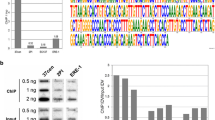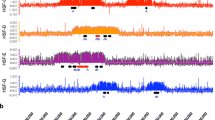Abstract
In situ hybridization of biotin-labeled mouse major satellite DNA clone pMR196 was applied toMus domesticus andMus spretus chromosomes (Chr). The same karyotypes were counterstained with distamycin A-DAPI to identify AT-rich heterochromatin. Chromosomes from the laboratory mouse, C57BL/6Ros (BL/6;M. domesticus) were uniformly labeled at the centromere except for the Y, while chromosomes from the divergentMus speciesM. spretus showed little or no hybridization. Differences betweenMus species in copy number of the major satellite DNA sequence were used to identify chromosomes ofM. domesticus andM. spretus in their F1 hybrids and to discriminatedomesticus andspretus centromeres in backross progeny. The distribution pattern of heterochromatic regions demonstrated by distamycin A-DAPI counterstaining was comparable with that of in situ hybridization with pMR196, suggesting that A-T rich heterochromatin inM. domesticus is mainly constructed by the pMR196-related sequence. The in situ technique was used to examine segregation ofdomesticus centromeres in backcross progeny obtained by mating F1 hybrid females withM. domesticus orM. spretus males. The segregation of centromeres did not deviate from the expected among the backcross progeny from C57BL/6Ros males, whereas chromosomes withM. domesticus centromeres were prone to appear in the progeny from backcross matings byM. spretus males.
Similar content being viewed by others
References
Avner, P., Amar, L., Dandolo, L. and Guenet J.-L.: Genetic analysis of the mouse using interspecific crosses.Trends Genet 4: 18–23, 1988.
Brown, S.D.M. and Dover, G.A.: Conservation of segmental variants of satellite DNA ofMus musculus in a related species:Mus spretus.Nature 285: 47–49, 1980.
Ceci, J., Siracusa, L.D., Jenkins, N.A. and Copeland, N.G.: A molecular genetic linkage map of mouse chromosome 4 including the localization of several protooncogenes.Genomics 5: 699–709, 1990.
Chapman, V.M., Kratzer, P.G. and Quarantillo, B.A.: Electrophoretic variation for X chromosome-linked hypoxanthine phosphoribosyl transferase (HPRT) in wild-derived mice.Genetics 103: 785–795, 1983.
Elliott, R.W. and Yen, C.-H.: DNA variants with telomere probe enable genetic mapping of ends of mouse chromosomes.Mammalian Genome 1: 000-000, 1991.
Feinberg, A.P. and Vogelstein, B.: A technique for radiolabeling DNA restriction endonuclease fragments to high specific activity.Anal Biochem 132: 6–13, 1983.
Flamm, W.G., McCallum, M. and Walker P.M.B.: The isolation of complementary strands from a mouse DNA fraction.Proc Natl Acad Sci USA 57: 1729–1734, 1967.
Jones, K.W.: Chromosomal and nuclear location of mouse satellite DNA in individual cells.Nature 225: 912–915, 1970.
Justice M.J., Siracusa, L.D., Gilbert, D.J., Heisterkamp, N., Groffen, J., Chada, K., Silan, C.M., Copeland, N.G. and Jenkins, N.A.: A genetic linkage map of mouse chromosome 10: Localization of eighteen molecular markers using a single interspecific backcross.Genetics 125: 855–866, 1990.
Kit, S.: Equilibrium sedimentation in density gradients of DNA preparations from animal tissues.J Mol Biol 3: 711–716, 1961.
Maniatis, T., Fritsch, E.F. and Sambrook, J.:Molecular Cloning: A Laboratory Manual, Cold Spring Harbor Laboratory Press, New York, 1982.
Mullins, L.J., Stephenson, D.A., Grant, S.G. and Chapman, V.M.: Efficient linkage of ten loci in the proximal region of the mouse X chromosome.Genomics 7: 19–30, 1990.
Pardue, M.L. and Gall, J.G.: Chromosomal localization of mouse satellite DNA.Science 168: 1356–1358, 1970.
Pietras, D.F., Bennet, K.L., Siracusa, L.D., Woodworth-Gutai, M., Chapman, V.M., Gross, K.W., Kane-Haas, C. and Hastie, N.D.: Construction of a smallMus musculus repetitive DNA library: Identification of a new satellite sequence inMus musculus.Nuc Acids Res 11: 6965–6983, 1983.
Pinkel, D., Straume, T. and Gray, J.W.: Cytogenetic analysis using quantitative, high-sensitivity fluorescence hybridization.Proc Natl Acad Sci USA 83: 2934–2938, 1986.
Redi, C.A., Garagna, S., Della Valle, G., Bottiroli, G., Dell'Orto, P., Viale, G., Peverali, F.A., Raimondi, E. and Forejt, J.: Differences in the organization and chromosomal allocation of satellite DNA between the European long tailed house miceMus domesticus andMus musculus.Chromosoma 99: 11–17, 1990.
Rice, N.R. and Straus, N.A.: Relatedness of mouse satellite deoxyribonucleic acid to deoxyribonucleic acid of variousMus species.Proc Natl Acad Sci USA 70: 3546–3550, 1973.
Rossant, J., Vijh, M., Siracusa, L.D. and Chapman, V.M.: Identification of embryonic cell lineages in histological sections ofM. musculus-M. caroli chimeras.J Embryol Exp Morph 73: 179–191, 1983.
Schwarzacher-Robinson, T., Cram, L.S., Meyne, J. and Moyzis, P.K.: Characterization of human heterochromatin by in situ hybridization with satellite DNA clones.Cytogenet Cell Genet 47: 192–196, 1988.
Schweizer, D., Ambros, P. and Andrle, M.: Modification of DAPI banding on human chromosomes by prestaining with a DNA-binding oligopeptide antibiotic, distamycin A.Exp Cell Res 111: 327–332, 1978.
Seldin, M.F., Howard, T.A. and D'Eustachio, P.: Comparison of linkage maps of mouse chromosome 12 derived from laboratory strain intraspecific andMus spretus interspecific backcrosses.Genomics 5: 24–28, 1989.
Singer, M.F.: Highly repeated sequences in mammalian genomes.Int Rev Cytol 76: 67–112, 1982.
Siracusa, L.D.: Molecular and genetic analysis of satellite DNA in the mouse, Doctoral Thesis, State University of New York at Buffalo, 1985.
Siracusa, L.D., Buchberg, A.M., Copeland, N.G. and Jenkins, N.A.: Recombinant inbred strain and interspecific backcross analysis of molecular markers flanking the murineagouti coat color locus.Genetics 122: 669–679, 1989.
Siracusa, L.D., Chapman, V.M., Bennett, K.L., Hastie, N.D., Pietras, D.F. and Rossant, J.: Use of repetitive DNA sequences to distinguishMus musculus andMus caroli cells by in situ hybridization.J Embryol Exp Morph 73: 163–178, 1983.
Sutton, W.D. and McCallum, M.: Related satellite DNAs in the genusMus.J Mol Biol 71: 633–656, 1972.
Yunis, J.J. and Yasmineh, W.G.: Heterochromatin, satellite DNA and cell function.Science 174: 1200–1209, 1971.
Author information
Authors and Affiliations
Rights and permissions
About this article
Cite this article
Matsuda, Y., Chapman, V.M. In situ analysis of centromeric satellite DNA segregating inMus species crosses. Mammalian Genome 1, 71–77 (1991). https://doi.org/10.1007/BF02443781
Received:
Accepted:
Issue Date:
DOI: https://doi.org/10.1007/BF02443781




